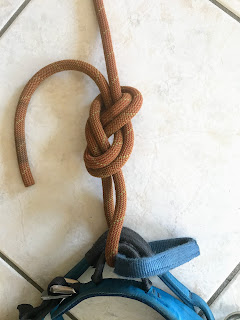Tying off a Munther hitch - skip the Mule
Knots should not just be useful. They need to be easy to teach and hard to get wrong even under stress.
A very important skill for any climber is to be able to tie off a belay device or Munther hitch. Whenever you need to get your hands free for a snack, a photo, or transfer loads in a rescue situation, that passive end needs to go somewhere.
 | |
|
I should start by making it very clear that this is a tried and tested method. Technically, there is nothing wrong with a properly tied Munther-Mule combination, and if you like it, use it! But I strive to teach knots that are easy to use, for beginners, but also for advanced climbers under stress. (For example, I don´t usually teach a bowline with Yosemite finish. It´s a great knot, but hard to teach and learn. Personally, I love it.)
Why don´t I like to teach it? The problem lies in the Mule. The slip-knot part of it - that which you tie right after the Munther itself - starts with a twist. If you get that twist in the wrong direction, you end up with something that is not quite a Mule. Now, "not quite" can be a rather catastrophic detail with knots. In this case, however, a mistake will not be catastrophic. The knot is always backed up with an extra half hitch or overhand around the active rope. You will get some slippage, which can be annoying, but your knot will probably hold. (I say "probably" because I have not been able to collapse it; this does not mean that it couldn´t fail.)
What is problematic is the insecurity this potential for error creates. It slows the climber down and adds stress. At every rescue course I have given, students are always unsure about this knot, losing precious seconds. Even after a lot of practice. This is even true for myself.
This is why I humbly propose using a double half hitch instead. It is very simple; in fact, it is the same as what you use to back up your Mule slip-knot, only you do it twice. It is easy to tie, and easy to get tight so as to avoid slippage. I have not been able to find any real draw-back.
 |
| The Munther with a half-hitch tie-off. Again, final backup half hitch has been omitted. |
Under stress (and believe me, in a real rescue or in a snow storm, it will be real stress) we must be able to operate on autopilot. Our cognitive bandwidth is minimal, and only that which is engrained in motor memory will work. If you are one of those people who practise unusual knots every day, you will be fine with the Munther-Mule. Most people are not like that. We are good at the knots we use in climbing and everyday life. For me, the double half hitch is such a knot.
Here is a short video that probably explains all the above better than words! Plus, you get to see my living room!



Comments
Post a Comment